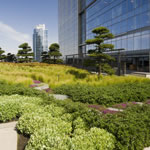Underneath the excitement about the proliferation of vegetated roofs hangs a nagging question: Will these stand the test of time? As an early adopter of the vegetated roof, the 23,000-square-foot garden on the 17th floor of the Russell Investments Center in downtown Seattle, installed in 2006, gives us a look into the future of the green roofs being planted today.
The project came with challenges. Seattle receives 150 days of precipitation per year though actual rainfall is only 37 inches (New York City averages 50 inches per year). The garden’s south and west orientations are exposed to the Puget Sound, which sends an occasional onslaught of high winds and heavy rainfall. Add to this that priceless works at the Seattle Art Museum are located one floor down, which means that leaky roofs and water damage are especially unwelcome.
Dennis Yanez, national marketing manager for American Hydrotech, which provided its Monolithic Membrane, a hot rubberized asphalt rooftop that serves as the bathtub for the entire installation, says the building has nothing to worry about. After seven years, the roof is leak-free, the plants are thriving, and it’s one of the most popular spots in the city.

Seattle incentivizes green roofs in both commercial and residential applications because 50-75% of the precipitation in the city does not currently get absorbed or reused.
The original client, Washington Mutual Bank, built the green roof before dissolving in the financial crisis of 2008 (the building now houses Russell Investments, a subsidiary of Northwestern Mutual). The bank told landscape architect Chris Phillips, of Phillips Farevaag Smallenberg in Vancouver, British Columbia, that it wanted employees to have access to fresh air and sunlight. “They were very enthusiastic about the well-being of their people,” Phillips says.
The plan called for a diverse plant system that would be aesthetically pleasing and attractive to employees, effectively turning the concept of the windowless employee lunchroom inside out. Native pine trees, bamboo, and grasses fit the site conditions with cross-cables in the shallow, 12- to 36-inch-deep soil to brace trees against those occasional windstorms. A hat-like partial roof protects plantings from downdrafts along the curtainwall that rises above the garden to the top of the building at 42 stories. “A balance between aesthetics and drought tolerance was the key,” Yanez says of the project, which received an Honor Award from the American Society of Landscape Architects in 2007.
Visitors can take in the surrounding mountains and the Puget Sound through a mounted telescope, and an oversized abacus is a subtle nod to the financial industry and contrasts with the contemporary aluminum-and-cedar trellis and slate boulders that mimic Washington’s Olympic Mountains. All elements can be seen from an inside lunch area that has floor-to-ceiling windows, maintaining the roof deck as a popular place every day, rain or shine.

